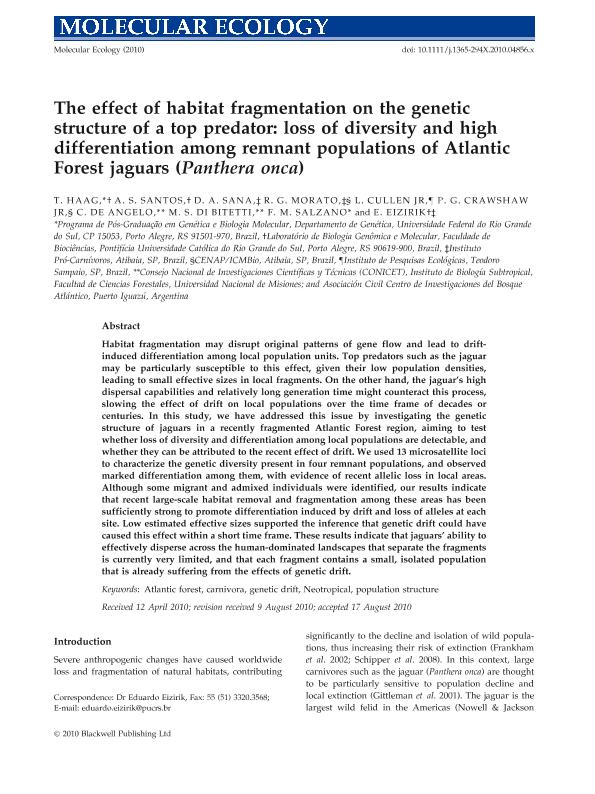Mostrar el registro sencillo del ítem
dc.contributor.author
Haag, Taiana

dc.contributor.author
Santos, Analisie S.

dc.contributor.author
Sana, Dênis A.

dc.contributor.author
Morato, Ronaldo G.

dc.contributor.author
Cullen Jr., Laury

dc.contributor.author
Crawshaw Jr., Peter G.

dc.contributor.author
de Angelo, Carlos Daniel

dc.contributor.author
Di Bitetti, Mario Santiago

dc.contributor.author
Salzano, Francisco M.

dc.contributor.author
Eizirik, Eduardo

dc.date.available
2018-08-21T19:17:44Z
dc.date.issued
2010-08
dc.identifier.citation
Haag, Taiana; Santos, Analisie S.; Sana, Dênis A.; Morato, Ronaldo G.; Cullen Jr., Laury; et al.; The effect of habitat fragmentation on the genetic structure of a top predator: loss of diversity and high differentiation among remnant populations of Atlantic Forest jaguars (Panthera onca); Wiley Blackwell Publishing, Inc; Molecular Ecology; 19; 22; 8-2010; 4906-4921
dc.identifier.issn
0962-1083
dc.identifier.uri
http://hdl.handle.net/11336/56414
dc.description.abstract
Habitat fragmentation may disrupt original patterns of gene flow and lead to drift‐induced differentiation among local population units. Top predators such as the jaguar may be particularly susceptible to this effect, given their low population densities, leading to small effective sizes in local fragments. On the other hand, the jaguar’s high dispersal capabilities and relatively long generation time might counteract this process, slowing the effect of drift on local populations over the time frame of decades or centuries. In this study, we have addressed this issue by investigating the genetic structure of jaguars in a recently fragmented Atlantic Forest region, aiming to test whether loss of diversity and differentiation among local populations are detectable, and whether they can be attributed to the recent effect of drift. We used 13 microsatellite loci to characterize the genetic diversity present in four remnant populations, and observed marked differentiation among them, with evidence of recent allelic loss in local areas. Although some migrant and admixed individuals were identified, our results indicate that recent large‐scale habitat removal and fragmentation among these areas has been sufficiently strong to promote differentiation induced by drift and loss of alleles at each site. Low estimated effective sizes supported the inference that genetic drift could have caused this effect within a short time frame. These results indicate that jaguars’ ability to effectively disperse across the human‐dominated landscapes that separate the fragments is currently very limited, and that each fragment contains a small, isolated population that is already suffering from the effects of genetic drift.
dc.format
application/pdf
dc.language.iso
eng
dc.publisher
Wiley Blackwell Publishing, Inc

dc.rights
info:eu-repo/semantics/openAccess
dc.rights.uri
https://creativecommons.org/licenses/by-nc-sa/2.5/ar/
dc.subject
Panthera Onca
dc.subject
Atlantic Forest
dc.subject
Genetic Diversity
dc.subject
Population Structure
dc.subject
Carnivora
dc.subject
Genetic Drift
dc.subject
Neotropical
dc.subject.classification
Otras Ciencias Biológicas

dc.subject.classification
Ciencias Biológicas

dc.subject.classification
CIENCIAS NATURALES Y EXACTAS

dc.title
The effect of habitat fragmentation on the genetic structure of a top predator: loss of diversity and high differentiation among remnant populations of Atlantic Forest jaguars (Panthera onca)
dc.type
info:eu-repo/semantics/article
dc.type
info:ar-repo/semantics/artículo
dc.type
info:eu-repo/semantics/publishedVersion
dc.date.updated
2018-08-17T19:01:08Z
dc.identifier.eissn
1365-294X
dc.journal.volume
19
dc.journal.number
22
dc.journal.pagination
4906-4921
dc.journal.pais
Estados Unidos

dc.journal.ciudad
Hoboken
dc.description.fil
Fil: Haag, Taiana. Universidade Federal do Rio Grande do Sul; Brasil. Pontificia Universidade Católica do Rio Grande do Sul; Brasil
dc.description.fil
Fil: Santos, Analisie S.. Pontificia Universidade Católica do Rio Grande do Sul; Brasil
dc.description.fil
Fil: Sana, Dênis A.. Instituto Pró-Carnívoros; Brasil
dc.description.fil
Fil: Morato, Ronaldo G.. Centro Nacional de Pesquisa e Conservaçao de Mamíferos Carnívoros; Argentina. Instituto Pró-Carnívoros; Brasil
dc.description.fil
Fil: Cullen Jr., Laury. Instituto de Pesquisas Ecológicas; Brasil
dc.description.fil
Fil: Crawshaw Jr., Peter G.. Centro Nacional de Pesquisa e Conservaçao de Mamíferos Carnívoros; Argentina
dc.description.fil
Fil: de Angelo, Carlos Daniel. Consejo Nacional de Investigaciones Científicas y Técnicas. Centro Científico Tecnológico Conicet - Nordeste. Instituto de Biología Subtropical. Instituto de Biología Subtropical - Nodo Puerto Iguazú | Universidad Nacional de Misiones. Instituto de Biología Subtropical. Instituto de Biología Subtropical - Nodo Puerto Iguazú; Argentina. Centro de Investigaciones del Bosque Atlántico; Argentina
dc.description.fil
Fil: Di Bitetti, Mario Santiago. Consejo Nacional de Investigaciones Científicas y Técnicas. Centro Científico Tecnológico Conicet - Nordeste. Instituto de Biología Subtropical. Instituto de Biología Subtropical - Nodo Puerto Iguazú | Universidad Nacional de Misiones. Instituto de Biología Subtropical. Instituto de Biología Subtropical - Nodo Puerto Iguazú; Argentina. Centro de Investigaciones del Bosque Atlántico; Argentina
dc.description.fil
Fil: Salzano, Francisco M.. Universidade Federal do Rio Grande do Sul; Brasil
dc.description.fil
Fil: Eizirik, Eduardo. Pontificia Universidade Católica do Rio Grande do Sul; Brasil
dc.journal.title
Molecular Ecology

dc.relation.alternativeid
info:eu-repo/semantics/altIdentifier/doi/http://dx.doi.org/10.1111/j.1365-294X.2010.04856.x
dc.relation.alternativeid
info:eu-repo/semantics/altIdentifier/url/https://onlinelibrary.wiley.com/doi/abs/10.1111/j.1365-294X.2010.04856.x
Archivos asociados
